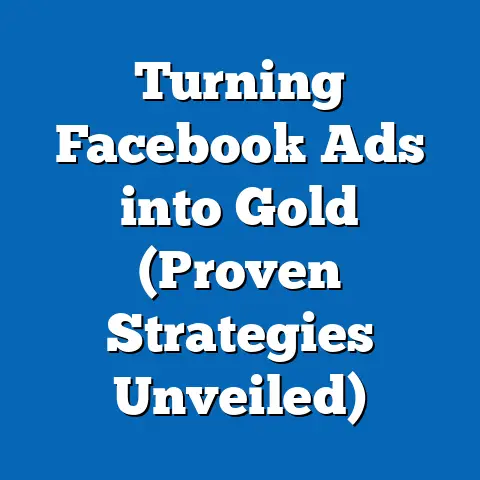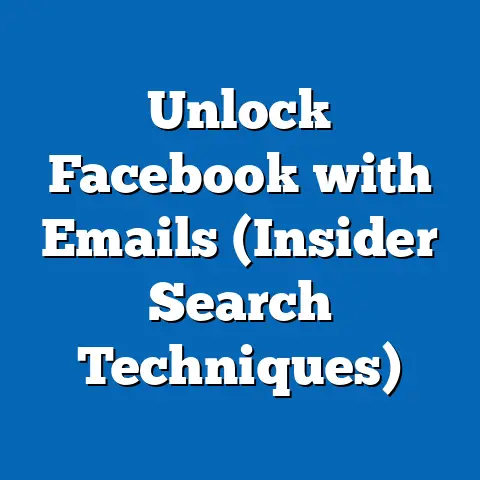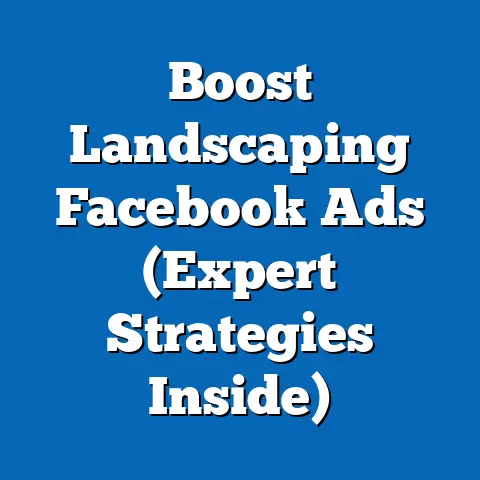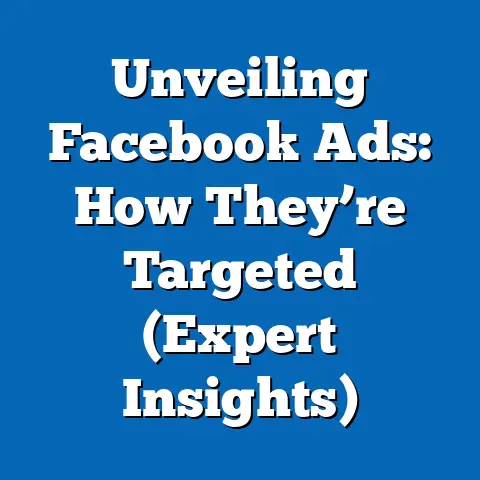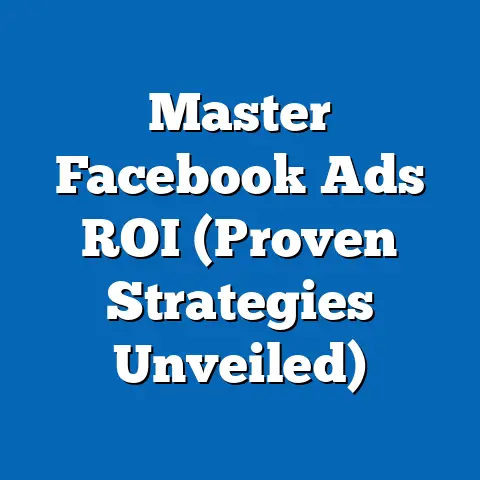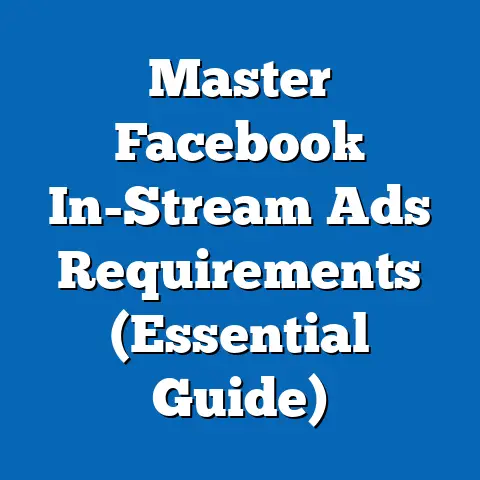Craft High-Converting Facebook Ads (Expert Strategies Revealed)
Facebook. It’s a name synonymous with social connection, endless scrolling, and, increasingly, a powerhouse for advertising. I’ve spent years navigating the ever-changing landscape of Facebook Ads, witnessing firsthand the incredible potential it holds for businesses of all sizes. We’re not just talking about throwing a few dollars at a boosted post and hoping for the best. I’m talking about crafting strategic, laser-focused campaigns that drive real results – leads, sales, and unwavering brand loyalty.
With over 2.8 billion monthly active users, Facebook offers an unparalleled reach, a virtual marketplace teeming with potential customers. But simply being present on the platform isn’t enough. The key lies in crafting ads that not only grab attention but also resonate deeply with your target audience, compelling them to take action. This is where the art and science of high-converting Facebook ads come into play.
In this guide, I’m going to pull back the curtain and share the expert strategies I’ve learned through years of experience, countless campaigns, and a relentless pursuit of understanding what truly makes a Facebook ad convert. We’ll dive deep into the psychology behind effective ads, explore the key elements that drive engagement, and uncover advanced targeting techniques that will help you reach the right people with the right message at the right time.
This isn’t just another surface-level overview. This is a comprehensive roadmap to mastering the art of Facebook advertising and unlocking its full potential for your business. So, buckle up, and let’s get started!
Section 1: Understanding Facebook Ads
Before we jump into the nitty-gritty of crafting high-converting ads, let’s make sure we’re all on the same page regarding the fundamentals of Facebook advertising.
1.1 Overview of Facebook Advertising
Facebook advertising, at its core, is a system that allows businesses to display targeted ads to users of the Facebook platform. These ads can take many forms, from simple image ads to engaging video ads and interactive experiences.
But what sets Facebook advertising apart is its unparalleled targeting capabilities. Unlike traditional advertising, which often relies on broad demographics and guesswork, Facebook allows you to pinpoint your ideal customer with incredible precision. You can target users based on their:
- Demographics: Age, gender, location, education, relationship status, etc.
- Interests: Hobbies, activities, pages they’ve liked, groups they’ve joined, etc.
- Behaviors: Purchase history, online activity, device usage, travel habits, etc.
This level of granularity allows you to create highly relevant ads that resonate with your target audience, dramatically increasing your chances of conversion.
Why is Facebook Advertising so Effective?
The effectiveness of Facebook advertising is backed by compelling data. According to Statista, Facebook’s ad revenue continues to climb, demonstrating its importance to businesses worldwide. Here are a few key statistics that highlight the power of Facebook ads:
- Reach: Facebook reaches billions of potential customers globally.
- ROI: Many businesses report a significantly higher ROI from Facebook ads compared to other digital marketing channels.
- Engagement: Facebook ads can drive significant engagement, leading to increased brand awareness and customer loyalty.
I remember one particular campaign I ran for a local bakery. Instead of simply promoting their general menu, we targeted users within a 5-mile radius who had expressed interest in “gluten-free baking” or “vegan desserts.” The result? A surge in orders for their specialty items and a loyal customer base who felt genuinely understood.
Key Takeaway: Facebook advertising offers unmatched targeting capabilities and the potential for high ROI when executed strategically.
1.2 The Facebook Ads Ecosystem
To truly understand how to craft high-converting Facebook ads, you need to grasp the underlying structure of the Facebook Ads Manager. Think of it as a hierarchical system, with each level playing a crucial role in the overall success of your campaigns.
- Campaign: This is the top-level structure that defines your overall advertising objective. Are you looking to drive website traffic, generate leads, increase brand awareness, or boost sales? Facebook offers a variety of campaign objectives to choose from, each designed to optimize your ads for a specific outcome.
- Ad Set: Within each campaign, you’ll create one or more ad sets. Ad sets define your target audience, budget, schedule, and ad placement (where your ads will appear, such as Facebook News Feed, Instagram Stories, or Audience Network). This is where the magic of Facebook targeting truly comes to life.
- Ad: This is the actual creative element that your audience will see. It includes your ad copy, visuals (images or videos), and call-to-action button. The ad is the final piece of the puzzle, and its effectiveness hinges on how well it aligns with your campaign objective and target audience.
Key Terms to Know:
- Impressions: The number of times your ad is displayed to users.
- Reach: The number of unique users who have seen your ad.
- Clicks: The number of times users have clicked on your ad.
- Click-Through Rate (CTR): The percentage of impressions that resulted in a click (Clicks / Impressions). A higher CTR generally indicates that your ad is relevant and engaging.
- Conversions: The number of users who completed a desired action after clicking on your ad (e.g., making a purchase, filling out a form, subscribing to a newsletter).
- Conversion Rate: The percentage of clicks that resulted in a conversion (Conversions / Clicks). A higher conversion rate indicates that your landing page and overall funnel are effective.
- Cost Per Click (CPC): The average cost you pay for each click on your ad (Total Spend / Clicks).
- Cost Per Acquisition (CPA): The average cost you pay for each conversion (Total Spend / Conversions).
- Return on Ad Spend (ROAS): The revenue generated from your ads divided by the total ad spend (Revenue / Total Spend).
Takeaway: Understanding the Facebook Ads Manager structure and key advertising metrics is crucial for creating and optimizing effective campaigns.
Next Steps: Familiarize yourself with the Facebook Ads Manager interface. Create a test campaign to explore the different campaign objectives, ad set options, and ad formats.
Section 2: The Psychology Behind High-Converting Ads
Crafting high-converting Facebook ads isn’t just about technical skills; it’s about understanding the psychology of your audience and tapping into their motivations, desires, and pain points.
2.1 Understanding Your Audience
Before you even think about writing a single line of ad copy or selecting an image, you need to have a deep understanding of your target audience. Who are they? What are their interests, values, and aspirations? What problems are they trying to solve?
Facebook offers a powerful tool called Audience Insights that can help you gain valuable insights into your target audience. This tool allows you to explore the demographics, interests, behaviors, and page likes of your existing customers or potential customers.
Using Audience Insights:
- Define Your Target Audience: Start by defining your ideal customer based on demographics, interests, and behaviors.
- Explore Audience Insights: Navigate to the Audience Insights tool within the Facebook Ads Manager.
- Enter Your Criteria: Input your target audience criteria (e.g., age, location, interests).
- Analyze the Data: Explore the data provided by Audience Insights, paying attention to demographics, page likes, location, activity, household income, and purchase behavior.
Beyond Demographics:
While demographics are important, don’t stop there. Dig deeper into your audience’s psychographics – their values, attitudes, interests, and lifestyle. What motivates them? What are their fears and frustrations?
I once worked with a fitness brand that was struggling to reach its target audience. After conducting thorough audience research, we discovered that their ideal customers weren’t just interested in losing weight; they were driven by a desire to feel confident, empowered, and healthy. We adjusted our ad messaging to reflect these deeper motivations, and the results were dramatic.
Takeaway: Deeply understanding your target audience is essential for crafting relevant and compelling ads that resonate with them on an emotional level.
2.2 Crafting a Compelling Message
Once you understand your audience, you can start crafting a compelling message that speaks directly to their needs and desires. This is where the art of copywriting comes into play.
Emotional Triggers:
Effective ad copy often taps into emotional triggers that motivate users to take action. Some common emotional triggers include:
- Fear of Missing Out (FOMO): Create a sense of urgency and scarcity to encourage immediate action.
- Social Proof: Highlight testimonials, reviews, and social shares to build trust and credibility.
- Pain Point: Address a specific problem or frustration that your target audience is experiencing.
- Desire: Appeal to their aspirations and desires, showcasing how your product or service can help them achieve their goals.
- Curiosity: Use intriguing headlines and questions to pique their interest and encourage them to click.
Storytelling:
Storytelling is a powerful way to connect with your audience on an emotional level. Share real-life stories of how your product or service has helped others. This can be far more effective than simply listing features and benefits.
Value Proposition:
Clearly communicate the value that your product or service offers. What problem does it solve? How will it improve their lives? Make sure your value proposition is clear, concise, and compelling.
I remember working on a campaign for a SaaS company that offered project management software. Instead of focusing on the technical features of the software, we crafted a story about a team that was struggling to meet deadlines and improve collaboration. We then showed how the software helped them overcome these challenges and achieve remarkable results. This storytelling approach resonated deeply with our target audience and led to a significant increase in sign-ups.
Takeaway: Crafting a compelling message that resonates with your target audience’s emotions, desires, and pain points is crucial for driving conversions.
Next Steps: Conduct thorough audience research using Facebook Audience Insights. Identify the key emotional triggers that motivate your target audience. Craft ad copy that speaks directly to their needs and desires, highlighting the value that your product or service offers.
Section 3: Key Elements of High-Converting Facebook Ads
Now that we’ve explored the psychology behind effective ads, let’s dive into the key elements that make a Facebook ad truly stand out and drive conversions.
3.1 Eye-Catching Visuals
In the fast-paced world of social media, visuals are king. Your ad’s image or video is often the first thing that catches a user’s eye, so it’s crucial to make a strong impression.
Best Practices for Image and Video Selection:
- High-Quality: Use high-resolution images and videos that are clear, crisp, and visually appealing.
- Relevance: Ensure that your visuals are relevant to your ad copy and target audience.
- Branding: Incorporate your brand’s colors, logo, and visual style to create a consistent brand experience.
- Emotion: Choose visuals that evoke emotion and connect with your target audience on a personal level.
- Action: Consider using visuals that depict people using your product or service, or that illustrate the desired outcome.
Image and Video Dimensions:
Facebook recommends specific image and video dimensions for different ad placements. It’s important to adhere to these specifications to ensure that your visuals are displayed correctly and look their best. You can find the latest specifications on the Facebook Ads Help Center.
Testing Different Visuals:
Don’t be afraid to experiment with different visuals to see what resonates best with your target audience. A/B testing different images and videos can reveal valuable insights into what types of visuals drive the most engagement and conversions.
I once ran a campaign for an e-commerce store selling handmade jewelry. Initially, we used product photos with a plain white background. However, after A/B testing, we discovered that lifestyle photos featuring people wearing the jewelry in everyday settings performed significantly better. This simple change in visuals led to a dramatic increase in click-through rates and sales.
Takeaway: Eye-catching visuals are essential for capturing attention and driving engagement on Facebook. Use high-quality images and videos that are relevant to your ad copy and target audience.
3.2 Persuasive Copywriting
While visuals grab attention, persuasive copywriting is what ultimately convinces users to take action. Your ad copy should be clear, concise, and compelling, highlighting the value that your product or service offers.
Key Elements of Persuasive Ad Copy:
- Headline: Your headline is the first thing users will read, so it needs to be attention-grabbing and intriguing. Use strong verbs, numbers, and question marks to pique their interest.
- Body Text: Your body text should provide more detail about your product or service, highlighting its key benefits and features. Focus on solving a problem or fulfilling a need.
- Call to Action (CTA): Your CTA is the final push that encourages users to take action. Use clear and concise language that tells them exactly what you want them to do (e.g., “Shop Now,” “Learn More,” “Sign Up”).
Techniques for Writing High-Performing Ad Copy:
- Use Strong Verbs: Start your headline and body text with strong verbs that convey action and excitement (e.g., “Discover,” “Unlock,” “Transform”).
- Highlight Benefits, Not Just Features: Focus on the benefits that your product or service offers, rather than just listing its features. How will it improve their lives?
- Use Social Proof: Incorporate testimonials, reviews, and social shares to build trust and credibility.
- Create a Sense of Urgency: Use language that creates a sense of urgency and scarcity, encouraging users to take action immediately.
- Personalize Your Message: Tailor your ad copy to your specific target audience, addressing their needs and desires.
Example of High-Performing Ad Copy:
Headline: “Unlock Your Dream Body in Just 30 Days!”
Body Text: “Tired of feeling sluggish and unhappy with your body? Our revolutionary fitness program will help you transform your physique and boost your confidence in just 30 days. Join thousands of satisfied customers who have achieved incredible results!”
Call to Action: “Get Started Now!”
Analysis:
- Headline: The headline uses strong verbs (“Unlock”) and a compelling promise (“Dream Body”) to grab attention.
- Body Text: The body text addresses a common pain point (feeling sluggish and unhappy) and highlights the key benefit (transforming your physique and boosting confidence).
- Call to Action: The CTA is clear and concise, telling users exactly what to do (“Get Started Now!”).
Takeaway: Persuasive copywriting is essential for convincing users to take action. Use strong verbs, highlight benefits, incorporate social proof, create urgency, and personalize your message.
3.3 Ad Formats and Their Impact
Facebook offers a variety of ad formats to choose from, each designed to achieve different marketing objectives. Choosing the right ad format can have a significant impact on your campaign’s performance.
Popular Facebook Ad Formats:
- Image Ads: Simple and effective for driving traffic to your website or promoting a specific product.
- Video Ads: Engaging and versatile for telling stories, showcasing product demos, and building brand awareness.
- Carousel Ads: Allow you to display multiple images or videos in a single ad, perfect for showcasing a range of products or features.
- Slideshow Ads: Combine multiple images into a dynamic video-like experience, ideal for creating visually appealing stories.
- Collection Ads: Designed for e-commerce businesses, allowing users to browse and purchase products directly from the ad.
- Lead Ads: Collect leads directly within the Facebook platform, making it easy for users to sign up for your newsletter or request more information.
- Instant Experience Ads: Full-screen, mobile-optimized ads that provide an immersive and engaging experience for users.
Choosing the Right Ad Format:
The best ad format for your campaign will depend on your marketing objectives, target audience, and budget. Consider the following factors when making your decision:
- Campaign Objective: What are you trying to achieve with your ad campaign? (e.g., website traffic, lead generation, sales)
- Target Audience: What type of content does your target audience prefer? (e.g., images, videos, interactive experiences)
- Budget: Some ad formats are more expensive than others.
I once worked with a travel agency that was promoting a new vacation package. Instead of using a simple image ad, we created a carousel ad that showcased multiple photos of the destination, along with pricing and itinerary details. This allowed users to explore the vacation package in more detail and ultimately led to a significant increase in bookings.
Takeaway: Choosing the right ad format is crucial for maximizing your campaign’s performance. Consider your marketing objectives, target audience, and budget when making your decision.
Next Steps: Experiment with different ad formats to see what works best for your business. Use A/B testing to compare the performance of different ad formats and identify which ones drive the most engagement and conversions.
Section 4: Advanced Targeting Strategies
We’ve already touched on the power of Facebook’s targeting capabilities, but let’s dive deeper into some advanced strategies that can help you reach even more specific and relevant audiences.
4.1 Leveraging Custom Audiences
Custom Audiences allow you to target users based on your existing customer data. This is a powerful way to reach people who are already familiar with your brand and are more likely to convert.
Types of Custom Audiences:
- Customer List: Upload a list of your existing customers’ email addresses, phone numbers, or Facebook user IDs.
- Website Traffic: Target users who have visited your website or specific pages on your website.
- App Activity: Target users who have interacted with your mobile app.
- Engagement: Target users who have engaged with your Facebook page or ads (e.g., liked a post, watched a video, clicked on an ad).
Creating a Custom Audience:
- Navigate to the Audiences Section: Within the Facebook Ads Manager, navigate to the “Audiences” section.
- Create a Custom Audience: Click on the “Create Audience” button and select “Custom Audience.”
- Choose Your Source: Select the source of your customer data (e.g., customer list, website traffic).
- Upload Your Data or Configure Your Settings: Follow the instructions to upload your customer data or configure your website traffic settings.
- Name Your Audience: Give your audience a descriptive name that will help you remember it later.
Retargeting Website Visitors:
Retargeting website visitors is a particularly effective strategy for driving conversions. By targeting users who have already shown interest in your products or services, you can increase the likelihood that they will make a purchase or take another desired action.
I once ran a retargeting campaign for an e-commerce store that was struggling to convert website visitors into customers. We targeted users who had added items to their shopping cart but hadn’t completed the checkout process. We showed them ads featuring the items they had left in their cart, along with a special discount code. This simple retargeting campaign led to a significant increase in sales.
Takeaway: Custom Audiences are a powerful way to target users based on your existing customer data. Retargeting website visitors is a particularly effective strategy for driving conversions.
4.2 Lookalike Audiences for Expansion
Lookalike Audiences allow you to find new customers who are similar to your existing customers. This is a great way to expand your reach and target people who are more likely to be interested in your products or services.
How Lookalike Audiences Work:
Facebook analyzes the characteristics of your source audience (e.g., your customer list or website visitors) and identifies users who share similar demographics, interests, and behaviors.
Creating a Lookalike Audience:
- Navigate to the Audiences Section: Within the Facebook Ads Manager, navigate to the “Audiences” section.
- Create a Lookalike Audience: Click on the “Create Audience” button and select “Lookalike Audience.”
- Choose Your Source: Select the source audience that you want to use as the basis for your Lookalike Audience (e.g., your customer list or website visitors).
- Select Your Location: Choose the location that you want to target with your Lookalike Audience.
- Choose Your Audience Size: Select the size of your Lookalike Audience. A smaller audience size will be more similar to your source audience, while a larger audience size will be less similar but will have a wider reach.
Scaling Campaigns with Lookalike Audiences:
Lookalike Audiences are an effective way to scale your Facebook ad campaigns. By targeting new customers who are similar to your existing customers, you can increase your chances of success and drive more conversions.
I once worked with a subscription box company that was looking to expand its customer base. We created a Lookalike Audience based on their existing customer list and targeted users who shared similar interests and demographics. This Lookalike Audience performed extremely well, driving a significant increase in new subscribers.
Takeaway: Lookalike Audiences are a powerful way to find new customers who are similar to your existing customers. This is a great way to expand your reach and scale your Facebook ad campaigns.
4.3 Behavioral and Demographic Targeting
In addition to Custom and Lookalike Audiences, Facebook offers a wide range of behavioral and demographic targeting options that allow you to reach highly specific audiences.
Behavioral Targeting:
Target users based on their online activity, purchase history, device usage, travel habits, and other behaviors.
Demographic Targeting:
Target users based on their age, gender, location, education, relationship status, job title, and other demographic information.
Examples of Behavioral and Demographic Targeting:
- Targeting Parents: Target parents of young children with ads for baby products.
- Targeting Homeowners: Target homeowners with ads for home improvement services.
- Targeting Travelers: Target users who have recently traveled to a specific location with ads for hotels or tours.
- Targeting Tech Enthusiasts: Target users who have expressed interest in technology with ads for new gadgets or software.
I once worked with a local restaurant that was promoting a special offer for students. We targeted users who were currently enrolled in a local university and showed them ads featuring the student discount. This highly targeted campaign led to a significant increase in student traffic to the restaurant.
Takeaway: Facebook’s behavioral and demographic targeting options allow you to reach highly specific audiences with your ads. Use these options to create targeted campaigns that resonate with your ideal customers.
Next Steps: Experiment with Custom Audiences, Lookalike Audiences, and behavioral and demographic targeting options to find the most effective targeting strategies for your business. Use A/B testing to compare the performance of different audiences and identify which ones drive the most engagement and conversions.
Section 5: Optimizing Your Facebook Ads for Higher Conversions
Creating effective Facebook ads is an ongoing process. It’s not enough to simply set up your campaigns and let them run. You need to continuously monitor your ad performance, analyze the data, and make adjustments to your strategy to optimize your results.
5.1 A/B Testing for Continuous Improvement
A/B testing, also known as split testing, is a powerful technique for comparing different versions of your ads to see which ones perform best. By testing different elements of your ads, such as the headline, body text, image, or call to action, you can identify the winning combinations that drive the most engagement and conversions.
How A/B Testing Works:
- Identify a Variable: Choose a specific element of your ad that you want to test (e.g., headline, image, CTA).
- Create Two Versions: Create two different versions of your ad, each with a different variation of the variable you’re testing.
- Run Your Ads: Run your ads simultaneously, targeting the same audience.
- Track Your Results: Monitor the performance of each ad version, tracking key metrics such as impressions, clicks, CTR, and conversions.
- Analyze the Data: Analyze the data to determine which ad version performed better.
- Implement the Winner: Implement the winning ad version in your ongoing campaigns.
- Repeat the Process: Continuously A/B test different elements of your ads to optimize your performance over time.
What to A/B Test:
Takeaway: A/B testing is an essential technique for optimizing your Facebook ads for higher conversions. Continuously test different elements of your ads to identify the winning combinations that drive the most engagement and conversions.
5.2 Analyzing Ad Performance Metrics
Monitoring your ad performance is crucial for identifying areas where you can improve your campaigns. Facebook Ads Manager provides a wealth of data that can help you understand how your ads are performing and what changes you need to make.
Key Performance Indicators (KPIs) to Monitor:
- Impressions: The number of times your ad is displayed to users.
- Reach: The number of unique users who have seen your ad.
- Clicks: The number of times users have clicked on your ad.
- Click-Through Rate (CTR): The percentage of impressions that resulted in a click (Clicks / Impressions). A higher CTR generally indicates that your ad is relevant and engaging.
- Conversions: The number of users who completed a desired action after clicking on your ad (e.g., making a purchase, filling out a form, subscribing to a newsletter).
- Conversion Rate: The percentage of clicks that resulted in a conversion (Conversions / Clicks). A higher conversion rate indicates that your landing page and overall funnel are effective.
- Cost Per Click (CPC): The average cost you pay for each click on your ad (Total Spend / Clicks).
- Cost Per Acquisition (CPA): The average cost you pay for each conversion (Total Spend / Conversions).
- Return on Ad Spend (ROAS): The revenue generated from your ads divided by the total ad spend (Revenue / Total Spend).
Interpreting the Data:
- Low CTR: If your CTR is low, it may indicate that your ad is not relevant to your target audience or that your ad copy and visuals are not engaging.
- Low Conversion Rate: If your conversion rate is low, it may indicate that your landing page is not optimized for conversions or that your overall funnel is not effective.
- High CPC: If your CPC is high, it may indicate that your targeting is too broad or that your ad quality is low.
- High CPA: If your CPA is high, it may indicate that your ad campaign is not profitable or that you need to optimize your targeting, ad copy, and landing page.
Takeaway: Monitoring your ad performance and analyzing the data is crucial for identifying areas where you can improve your campaigns. Track key performance indicators (KPIs) such as CTR, conversion rate, CPC, and CPA to understand how your ads are performing and what changes you need to make.
5.3 Adjusting Strategy Based on Insights
The data you gather from monitoring your ad performance should inform your ongoing strategy. Don’t be afraid to make changes to your targeting, ad copy, visuals, or ad placements based on the insights you gain.
Strategies for Adjusting Your Ad Campaigns:
- Refine Your Targeting: If your ads are not reaching the right people, refine your targeting options to reach a more specific and relevant audience.
- Improve Your Ad Copy: If your ad copy is not engaging, experiment with different headlines, body text, and CTAs to see what resonates best with your audience.
- Optimize Your Visuals: If your visuals are not capturing attention, try different images and videos to see which ones drive the most engagement and conversions.
- Adjust Your Ad Placements: If your ads are not performing well in certain placements, try adjusting your ad placements to see if you can improve your results.
- Increase Your Budget: If your ads are performing well and you have room in your budget, consider increasing your budget to reach a larger audience and drive more conversions.
- Pause or End Underperforming Ads: If your ads are not performing well, don’t be afraid to pause or end them and focus your resources on the ads that are driving the best results.
I had a campaign that was performing well initially, but after a few weeks, the results started to decline. After analyzing the data, I realized that my target audience was experiencing ad fatigue. I refreshed my ad creative with new images and copy, and the performance immediately improved.
Takeaway: Being agile and responsive to data is essential for optimizing your Facebook ad campaigns for higher conversions. Continuously monitor your ad performance, analyze the data, and make adjustments to your strategy based on the insights you gain.
Next Steps: Set up a system for monitoring your ad performance on a regular basis. Analyze the data to identify areas where you can improve your campaigns. Be prepared to make changes to your targeting, ad copy, visuals, or ad placements based on the insights you gain.
Section 6: Real-World Examples and Case Studies
Let’s take a look at some real-world examples of successful and unsuccessful Facebook ad campaigns to gain a deeper understanding of what works and what doesn’t.
6.1 Successful Facebook Ad Campaigns
Case Study 1: Dollar Shave Club
Dollar Shave Club is a prime example of a company that has mastered the art of Facebook advertising. Their ads are known for their humor, wit, and relatable messaging.
- Strategy: Dollar Shave Club used video ads to tell their story and highlight the value of their subscription service. Their ads were funny, engaging, and memorable, which helped them to stand out from the competition.
- Results: Dollar Shave Club’s Facebook ad campaigns helped them to build a massive customer base and disrupt the traditional shaving industry.
Case Study 2: Airbnb
Airbnb has successfully used Facebook ads to target travelers and promote their listings.
- Strategy: Airbnb used a combination of image and video ads to showcase their unique properties and highlight the experiences that travelers can have in different destinations. They also used retargeting to reach users who had visited their website but hadn’t made a booking.
- Results: Airbnb’s Facebook ad campaigns helped them to increase brand awareness, drive traffic to their website, and generate bookings.
Case Study 3: Warby Parker
Warby Parker is known for their stylish and affordable eyeglasses. They have successfully used Facebook ads to promote their products and drive traffic to their website.
- Strategy: Warby Parker used high-quality product photos and lifestyle images to showcase their eyeglasses. They also used targeted ads to reach users who were interested in fashion and eyewear.
- Results: Warby Parker’s Facebook ad campaigns helped them to build a strong brand, increase website traffic, and drive sales.
Takeaway: Successful Facebook ad campaigns often share several common characteristics, including compelling visuals, persuasive ad copy, targeted messaging, and a clear call to action.
6.2 Lessons Learned from Failed Campaigns
It’s just as important to learn from failed campaigns as it is to learn from successful ones. Here are some common pitfalls and mistakes to avoid:
- Poor Targeting: Targeting the wrong audience is one of the most common mistakes made in Facebook advertising. If your ads are not reaching the right people, you’re unlikely to see positive results.
- Unengaging Ad Copy: If your ad copy is boring or irrelevant, users are unlikely to click on your ads. Make sure your ad copy is clear, concise, and compelling, highlighting the value that your product or service offers.
- Low-Quality Visuals: Using low-quality images or videos can damage your brand and turn users away. Make sure your visuals are high-resolution, visually appealing, and relevant to your ad copy.
- Lack of A/B Testing: Failing to A/B test your ads can prevent you from identifying the winning combinations that drive the most engagement and conversions.
- Ignoring Ad Performance: Failing to monitor your ad performance and make adjustments to your strategy can lead to wasted ad spend and missed opportunities.
I once worked on a campaign for a new mobile app. We spent a significant amount of money on Facebook ads, but we saw very few downloads. After analyzing the data, we realized that our ad copy was too technical and didn’t resonate with our target audience. We also discovered that our landing page was confusing and difficult to navigate. We revised our ad copy and landing page, and the performance of our campaign immediately improved.
Takeaway: Learning from failed campaigns is essential for avoiding common pitfalls and maximizing your chances of success. Pay attention to your targeting, ad copy, visuals, A/B testing, and ad performance to ensure that your campaigns are on track.
Next Steps: Analyze successful and unsuccessful Facebook ad campaigns to identify best practices and common mistakes. Use these insights to inform your own Facebook advertising strategy.
Section 7: Future Trends in Facebook Advertising
The world of Facebook advertising is constantly evolving. New features, technologies, and trends are emerging all the time, so it’s important to stay up-to-date on the latest developments.
7.1 The Role of AI and Automation
Artificial intelligence (AI) and automation are playing an increasingly important role in Facebook advertising. AI-powered tools can help you to:
- Automate Ad Creation: AI can generate ad copy, select images, and create ad variations based on your campaign objectives and target audience.
- Optimize Ad Targeting: AI can analyze data to identify the most effective targeting options for your ads.
- Automate Bidding: AI can automatically adjust your bids to maximize your return on ad spend.
- Improve Ad Performance: AI can continuously monitor your ad performance and make adjustments to your strategy to optimize your results.
Facebook itself is heavily investing in AI and machine learning to improve its advertising platform. Features like automated app ads and campaign budget optimization leverage AI to deliver better results with less manual effort.
Takeaway: AI and automation are transforming the landscape of Facebook advertising. Embrace these technologies to streamline your workflow, improve your ad performance, and maximize your return on ad spend.
7.2 Privacy Changes and Their Impact on Ads
Recent changes in privacy regulations, such as the General Data Protection Regulation (GDPR) and the California Consumer Privacy Act (CCPA), have had a significant impact on Facebook advertising. These regulations give users more control over their data and limit the ability of advertisers to track and target them.
Adapting to Privacy Changes:
- Focus on First-Party Data: Collect and leverage your own first-party data (e.g., customer email addresses, website activity) to target your ads.
- Use Contextual Targeting: Target users based on the content they are viewing or the context in which they are engaging with your ads.
- Prioritize Transparency: Be transparent with users about how you are collecting and using their data.
- Comply with Privacy Regulations: Ensure that your Facebook advertising practices comply with all applicable privacy regulations.
Apple’s App Tracking Transparency (ATT) framework, which requires apps to obtain user permission before tracking their activity across other apps and websites, has significantly impacted Facebook’s ability to target and measure ad performance. Advertisers need to adapt by focusing on aggregated data and exploring alternative measurement solutions.
Takeaway: Privacy changes are reshaping the future of Facebook advertising. Adapt to these changes by focusing on first-party data, using contextual targeting, prioritizing transparency, and complying with privacy regulations.
Next Steps: Stay up-to-date on the latest trends and developments in Facebook advertising. Experiment with AI-powered tools and adapt to privacy changes to ensure that your campaigns remain effective.
Conclusion
Facebook advertising presents an immense opportunity for businesses willing to invest the time and resources into crafting high-converting ads. By understanding the psychology behind effective ads, mastering the key elements that drive engagement, and leveraging advanced targeting strategies, you can unlock the full potential of Facebook advertising and achieve remarkable results.
Throughout this guide, I’ve shared the expert strategies I’ve learned through years of experience, countless campaigns, and a relentless pursuit of understanding what truly makes a Facebook ad convert. I encourage you to apply these strategies to your own Facebook advertising efforts and see the real results they can deliver.
Remember, creating effective Facebook ads is an ongoing process. Continuously monitor your ad performance, analyze the data, and make adjustments to your strategy based on the insights you gain. Be prepared to experiment, adapt, and stay up-to-date on the latest trends and developments in the world of Facebook advertising.
With dedication, persistence, and

